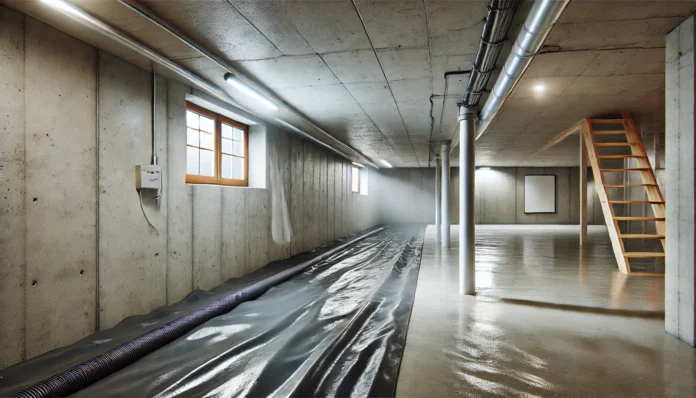It all depends on the basis! Regardless of whether it is a new build or an old building being renovated: if the basement has not been properly sealed, even years later, harmful moisture can still seep into the masonry. But what now? How can damage be repaired and the basement properly sealed afterwards? Don’t give mold and moisture any room and read our latest blog to find out how to properly seal your basement.
How to seal a basement: How to protect yourself from moisture
Our basements are the basis for all other floors – therefore, basement waterproofing represents a “fundamental” contribution to building protection. Basement waterproofing protects the foundation walls of the house and the basement from penetrating moisture. With basement waterproofing made of bitumen and other sealants, you can seal your basement and protect the masonry against moisture. In this blog, you will learn what types of basement waterproofing are available and how to proceed to ensure that mold and moisture do not stand a chance!
What types of basement waterproofing are there?
Which sealing system you should consider depends on the type of moisture exposure. In most cases, the moisture comes from outside. Continuous vertical sealing can help against moisture from outside. In some cases, sealing the cellar from the outside afterwards does not work and you have to resort to internal sealing. According to experts, internal sealing should only be a last resort. If internal sealing is necessary, it should be done very thoroughly and specialists should be called in.
Pro Tip: Find top local businesses & services across the U.S. on Tekmag Listings. Browse trusted listings, read reviews, and connect with professionals near you!
basement waterproofing from the outside
A basement waterproofing membrane should be applied to the outside of the basement walls when the building is being constructed. In some cases, subsequent renovation may be necessary, but we will go into this in more detail later. Whether the waterproofing should be done from the outside or the inside depends essentially on the structural situation and the available budget. If you want to waterproof the basement from the outside, you should follow these steps:
Step 1: Plastering correctly
If there is any excess plaster, this must be removed before applying a new coating. The new coating can only adhere to a solid substrate. Once the old plaster has been removed and new plaster has been applied, the drying time of up to 48 hours begins.
Step 2: Sealing with bitumen
You can apply the bitumen sealing compound with a trowel. A layer should be between 4 and 7 millimeters thick and also needs up to 48 hours to dry.
Step 3: The right insulation
To ensure that the basement is better insulated and energy costs are lower, you can install polystyrene insulation panels and a dimpled barrier sheet. In this step, you can use the bitumen sealing compound as an adhesive. The dimpled barrier sheet ensures that water drains away more quickly.
Step 4: Install drainage
Drainage ensures that rainwater does not accumulate on the floor slab. When laying the pipe, it should be 30-25 cm lower than the foundation surface. Important: The drainage must not be visible on the surface!
Basement waterproofing from the inside
As mentioned above, it may also be necessary to seal the basement from the inside. A lot of structural space is required for external sealing. If this is not available, you can resort to internal sealing. If damp walls or even mold are noticeable in the basement, you need to act quickly. There are two methods that can be used for internal sealing:
- horizontal barriers
- vertical barriers
The horizontal barrier blocks the water’s path into the masonry. The following methods are common:
Wall sawing method
Here the masonry is sawn open and a plastic plate is inserted into the cut. Wedge plates made of plastic are inserted into the remaining cutting height and the gaps are pressed with cement suspension.
Sheet metal impact method
In this method, corrugated chrome steel sheets are driven into a joint in the basement masonry in an overlapping manner using a mobile jackhammer.
Wall replacement method
In the wall replacement method, bricks are removed from the lower area, a sealing membrane is laid and the opening is bricked up again.
The horizontal barrier can also be used in combination with the vertical barrier to make the protection of the basement walls even more reliable.
The vertical barrier is used when water is pressing from the outside. The following options are available:
Curtain injection
During curtain injection, holes are drilled into the basement walls into which acrylate gel is then injected using low-pressure injection.
Surface injection
With surface injection, the drill holes do not penetrate the wall completely. Therefore, with this method, the gel is distributed within the masonry and forms the sealing veil.
Restoration plasters can also be used to prevent moisture from penetrating. Sometimes sealing slurries or component gelling can be useful.
Conclusion
A damp basement provides a breeding ground for mold, which can spread through small openings throughout the house. That’s why we recommend sealing your basement carefully! Consider which of the sealing options mentioned in the blog are suitable for you and make sure you consult a specialist if you want to counteract the damp in the basement in the long term.
































